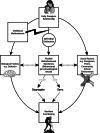A context-dependent model of resilient functioning after childhood maltreatment-the case for flexible biobehavioral synchrony
- PMID: 39333480
- PMCID: PMC11436866
- DOI: 10.1038/s41398-024-03092-7
A context-dependent model of resilient functioning after childhood maltreatment-the case for flexible biobehavioral synchrony
Abstract
Many children who experience childhood adversity, whether in the form of threat or deprivation, develop adaptive competencies that lead to resilient functioning. Still, research has not succeeded in accurately predicting the level of resilient functioning by any kind of biomarkers, likely because it has sidelined the flexibility inherent in a construct that is situationally and developmentally variable. Whilst recent research acknowledges the importance of redefining resilience in order to reflect its dynamic nature after adversity, evidence for specific behaviors that are developmentally adaptive and dynamic throughout the lifespan is limited. We here propose a model in which resilient functioning is crucially dependent on the individual's capability to flexibly synchronize with and segregate from another's cognitive-affective, behavioral, and physiological states, known as 'biobehavioral synchrony'. Such an adaptive interpersonal skill is rooted in (a) the early caregiving experience and its regulatory effects on an individual's physiological stress reactivity, as well as (b) the development of self-other distinction which can be affected by childhood maltreatment. Bridging the gap between accounts of flexible resilient functioning and the latest thinking in biobehavioral synchrony, we will review behavioral and neurobiological evidence that threat and deprivation in childhood interfere with the development of dynamic, context-sensitive boundaries between self and other, mediated by the (right) tempo-parietal junction (a central neural hub for interpersonal synchronization), which puts the individual at risk for affective fusion or cut-off from others' arousal states. Our proposed model charts a path for investigating the differential effects of maltreatment experiences and mechanisms for intergenerational transmission of non-sensitive caregiving. We conclude with metrics, data analysis methods, and strategies to facilitate flexible biobehavioral synchrony.
© 2024. The Author(s).
Conflict of interest statement
The authors declare no competing interests.
Figures



Similar articles
-
The complex neurobiology of resilient functioning after childhood maltreatment.BMC Med. 2020 Feb 13;18(1):32. doi: 10.1186/s12916-020-1490-7. BMC Med. 2020. PMID: 32050974 Free PMC article.
-
Protective factors associated with resilient functioning in young adulthood after childhood exposure to violence.Child Abuse Negl. 2014 Dec;38(12):1985-94. doi: 10.1016/j.chiabu.2014.10.010. Epub 2014 Oct 31. Child Abuse Negl. 2014. PMID: 25459988
-
Physiological and social synchrony as markers of PTSD and resilience following chronic early trauma.Depress Anxiety. 2021 Jan;38(1):89-99. doi: 10.1002/da.23106. Epub 2020 Oct 27. Depress Anxiety. 2021. PMID: 33107687
-
Annual Research Review: Resilient functioning in maltreated children--past, present, and future perspectives.J Child Psychol Psychiatry. 2013 Apr;54(4):402-22. doi: 10.1111/j.1469-7610.2012.02608.x. Epub 2012 Aug 28. J Child Psychol Psychiatry. 2013. PMID: 22928717 Free PMC article. Review.
-
Annual Research Review: Enduring neurobiological effects of childhood abuse and neglect.J Child Psychol Psychiatry. 2016 Mar;57(3):241-66. doi: 10.1111/jcpp.12507. Epub 2016 Feb 1. J Child Psychol Psychiatry. 2016. PMID: 26831814 Free PMC article. Review.
References
-
- WHO. Child maltreatment. Word Health Organ. 2022. https://www.who.int/news-room/fact-sheets/detail/child-maltreatment.
-
- Kessler RC. Posttraumatic stress disorder in the national comorbidity survey. Arch Gen Psychiatry. 1995;52:1048. - PubMed
-
- Galatzer-Levy IR, Huang SH, Bonanno GA. Trajectories of resilience and dysfunction following potential trauma: a review and statistical evaluation. Clin Psychol Rev. 2018;63:41–55. - PubMed
-
- Holmes MR, Yoon S, Berg KA, Cage JL, Perzynski AT. Promoting the development of resilient academic functioning in maltreated children. Child Abuse Negl. 2018;75:92–103. - PubMed
Publication types
MeSH terms
LinkOut - more resources
Full Text Sources
Medical
Miscellaneous

